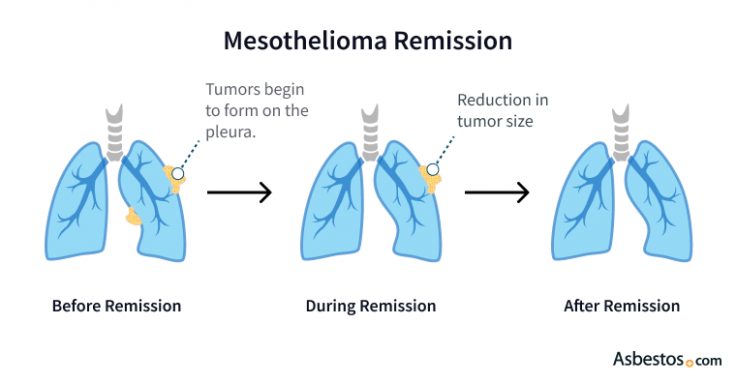
Dr. Jacques Fontaine is a thoracic surgeon at Moffitt Cancer Center in Tampa, Florida, where he heads up the Mesothelioma Research and Treatment Center. He specializes in minimally invasive robotic surgery and aggressive surgeries for mesothelioma.
Mesothelioma remission means tumors and symptoms have decreased for at least one month. Mesothelioma recurrence is defined as a return of cancer after treatment and remission, and it is common for this type of cancer. Anti-cancer therapies help control recurrences.
Mesothelioma remission means the cancer tumors have decreased in size by at least half or more. It marks a significant, positive turn in your overall health. It may mean you can reduce or temporarily stop treatment. Some patients may be able to go on some form of maintenance therapy.
Remission can bring considerable emotional and physical relief after aggressive treatments. It can also inspire real hope for patients and their families.
Learn about your diagnosis, top doctors and how to pay for treatment in our free mesothelioma guide.
Get Your GuideThe two types of remission include partial and complete remission. Doctors usually measure partial remission as at least a 50% reduction in tumor size. Complete remission indicates all signs of measurable cancer have disappeared. It’s rare with mesothelioma and not fully understood, but it is possible.
While mesothelioma can go into remission, recurrence often follows. Second-line treatments can help control recurrence.

Mesothelioma survivors can live for several years in partial remission despite tumor activity. It’s something doctors must watch and can treat as a chronic but manageable condition.
Anecdotal evidence shows few survivors have lived 10-15 years or more without recurrence. This result usually stems from an early diagnosis and an aggressive treatment approach.
Treatment is essential for achieving and maintaining remission in mesothelioma. It helps to reduce or eliminate signs of the cancer and keep it from coming back. Surgery is the treatment most likely to lead to prolonged remission and improve the mesothelioma survival rate. The EPP and P/D are among the mesothelioma surgeries most likely to result in remission.
Some patients have noted partial or complete remission with other anti-cancer treatments, including systemic chemotherapy, immunotherapy, targeted therapy, and Tumor-Treating Fields.
Patients also say dietary changes, nutritional supplements and oxygen therapy helped their remission.
It is possible to recover from aggressive treatment for mesothelioma and enter remission. Some survivors have remained in remission and extended their life expectancy with mesothelioma by three to 10 years or more. About 10% of all people diagnosed with mesothelioma live longer than five years.

Ease your mesothelioma symptoms with the right food. See recipes designed for you.
Get My Free GuideEPP is an extensive procedure intended to remove all visible mesothelioma tumors from the body. It extracts the affected lung and everything else at risk, such as the linings of the lung and heart. The procedure also extracts the diaphragm, which doctors later rebuild with prosthetic material.
Chemotherapy and radiation help kill the remaining cancer cells. Despite those efforts, recurrence generally happens at some point.
A 2020 Japanese study published in Oncology Letters reported most recurrences after an EPP develop three months after the procedure, compared to 20 months for another, less radical mesothelioma surgery known as pleurectomy and decortication.
Pleurectomy and decortication removes the lining around the lung, chest wall, heart and diaphragm. Doctors reconstruct the lining around the heart and diaphragm using mesh.
Sometimes, we get stuck in the concept of having to cure cancer and don’t always understand that we can be good at controlling it. It’s much more likely to be able to control [mesothelioma], than being able to kill every last [cancer] cell. If you can do that, you can live a long time with it.
The procedure is more tolerable than an EPP because the lung remains. But it is still an extensive surgery.
A 2020 Japanese study published in The Annals of Thoracic Surgery covering five years of data showed 63.3% of patients undergoing pleurectomy and decortication developed a recurrence an average of 19 months after surgery.
Mesothelioma recurrence is a return of cancer after treatment. It also happens after an extended period of remission. Recurrence differs from cancer progression, which occurs when tumors grow or spread.
Despite remission, mesothelioma recurs for all patients who undergo treatment. Recurrence happens because removing or killing every cancer cell is impossible. The remaining cancer cells eventually form tumors again.
The proximity of tumors to vital organs makes it difficult to remove every cancer cell. Doctors try to delay recurrence and keep cancer cells under control for as long as possible.
Mesothelioma recurs when cancer cells survive after surgery or chemotherapy. The cancer then grows again over time. When it returns, doctors define it in three ways.
Tumors return to the same spot or close to where they were first found. This type of recurrence may be the easiest to control if tumors are small and removable with surgery.
Tumors grow in tissues or lymph nodes near the original cancer location. If the tumors are small and limited in number, this type of recurrence may also respond well to surgery. Chemotherapy, immunotherapy, radiation therapy and targeted therapies control regional recurrences.
Metastatic cancer has spread to tissues far from the location of the original cancer. Mesothelioma rarely spreads to distant parts of the body. Local and regional recurrence is more common. Distant recurrences may respond well to all therapies used to control regional recurrences, except for surgery.
Surgery combined with chemotherapy and radiation can delay recurrence longer than other treatments. Immunotherapy and chemotherapy are the next most effective therapies to prolong recurrence.
Yes, researchers in clinical trials are testing new treatments for patients with recurrent mesothelioma, including new chemo and immunotherapy drugs.
Other trials research experimental therapies such as gene therapy and photodynamic therapy.
Yes, Cindy Christopher received her peritoneal mesothelioma diagnosis in 2006. She underwent extensive cytoreductive surgery and heated intraperitoneal chemotherapy (HIPEC) that same year.
“I was fortunate to find the right doctor and the right place to be. I asked questions. I did my homework,” Christopher said. “In a way, I was a guinea pig in a new protocol, and it worked. Not all cancer institutes are doing the same thing. I chose the best possible surgeon, and I told him definitively, I will be your best patient.”
Doctors diagnosed Trina Reif with peritoneal mesothelioma in 2001. Reif said recovery was challenging, but she’s proud of how far she’s come.
“I said if I could make my 20-year mark, I’d be so thrilled,” Reif said. “Every birthday is a blessing. Every year the good Lord gives me, I’m going to take.”
Recommended ReadingStay up-to-date on treatment, research, clinical trials, doctors and survivors
The information on this website is proprietary and protected. It is not a substitute for professional medical advice, diagnosis or treatment. Any unauthorized or illegal use, copying or dissemination will be prosecuted. Please read our privacy policy and terms of service for more information about our website.
This website and its content may be deemed attorney advertising. Prior results do not predict a similar outcome.
The Mesothelioma Center’s claim as the most trusted resource is based on our more than 150 5-star Google and BBB reviews. Our organization also helps more than half of all mesothelioma patients annually diagnosed.
Your web browser is no longer supported by Microsoft. Update your browser for more security, speed and compatibility.
If you are looking for mesothelioma support, please contact our Patient Advocates at (855) 404-4592
The Mesothelioma Center at Asbestos.com has provided patients and their loved ones the most updated and reliable information on mesothelioma and asbestos exposure since 2006.
Our team of Patient Advocates includes a medical doctor, a registered nurse, health services administrators, veterans, VA-accredited Claims Agents, an oncology patient navigator and hospice care expert. Their combined expertise means we help any mesothelioma patient or loved one through every step of their cancer journey.
More than 30 contributors, including mesothelioma doctors, survivors, health care professionals and other experts, have peer-reviewed our website and written unique research-driven articles to ensure you get the highest-quality medical and health information.
My family has only the highest compliment for the assistance and support that we received from The Mesothelioma Center. This is a staff of compassionate and knowledgeable individuals who respect what your family is experiencing and who go the extra mile to make an unfortunate diagnosis less stressful. Information and assistance were provided by The Mesothelioma Center at no cost to our family.LashawnMesothelioma patient’s daughter


Selby, K. (2025, July 31). Mesothelioma Remission and Recurrence. Asbestos.com. Retrieved December 23, 2025, from https://www.asbestos.com/mesothelioma/remission-recurrence/
Selby, Karen. "Mesothelioma Remission and Recurrence." Asbestos.com, 31 Jul 2025, https://www.asbestos.com/mesothelioma/remission-recurrence/.
Selby, Karen. "Mesothelioma Remission and Recurrence." Asbestos.com. Last modified July 31, 2025. https://www.asbestos.com/mesothelioma/remission-recurrence/.

Dr. Jacques Fontaine is a thoracic surgeon at Moffitt Cancer Center in Tampa, Florida, where he heads up the Mesothelioma Research and Treatment Center. He specializes in minimally invasive robotic surgery and aggressive surgeries for mesothelioma.
Our fact-checking process begins with a thorough review of all sources to ensure they are high quality. Then we cross-check the facts with original medical or scientific reports published by those sources, or we validate the facts with reputable news organizations, medical and scientific experts and other health experts. Each page includes all sources for full transparency.
Please read our editorial guidelines to learn more about our content creation and review process.
